

Rear Back Up Polymer Sight Flip Up with Windage Adjustment is engineered for tactical reliability. It mounts easily onto a 1913 Picatinny rail, making it ideal for precision shooting. An innovative shroud protects the aperture from debris and impact, allowing for confident deployment when it matters most. Its slim profile ensures compatibility with current magnifiers and optics, maintaining performance without compromise.
Constructed in the USA from military-grade reinforced polyamide, this robust sight features INFINITE MOA ADJUSTMENT, enabling precise windage tweaks with a flat head screwdriver. This allows for quick modifications on the fly, ensuring alignment with your target whether in the field or at the range. Equip your firearm with the BUPSWR for reliable performance in any situation.
Features:
- INNOVATIVE SHROUD protects the aperture from debris and impact damage.
- SLIM PROFILE fits under all current magnifiers and optics for seamless integration.
- INFINITE MOA ADJUSTMENT allows for precise windage tweaking with just a screwdriver.
- MILITARY-GRADE MATERIAL ensures durability and toughness under tough conditions.
- LIGHTWEIGHT CONSTRUCTION minimizes additional weight on your firearm.
- EASY DEPLOYMENT enables quick access in critical moments.
- MADE IN THE USA reflects superior manufacturing quality and craftsmanship.
- COMPATIBLE WITH STANDARD PICATINNY RAILS for versatile mounting options.
Technical Specifications Table
| Specifications | Details |
|---|---|
| Material | Military Grade Reinforced Polyamide |
| Mount Type | 1913 Picatinny Rail |
| Windage Adjustment | Infinite MOA |
| Dimensions | Compact and Slim |
| Weight | Lightweight |
What’s in the Box?
- Rear Back Up Polymer Sight Flip Up
- Mounting Hardware
- User Manual
Customer Reviews
"Best backup sight I've ever used! The shroud really keeps it safe from dirt and damage." - Jason R.
"Super easy to adjust and fits perfectly with my optics. Highly recommend!" - Mike T.
FAQ
How does the windage adjustment work? The BUPSWR features an Infinite MOA adjustment that allows you to make precise changes using a flat head screwdriver. This means you can quickly adapt to different shooting conditions, ensuring you’re on target every time.
Is it compatible with all rifles? Yes, this sight is designed to mount on standard 1913 Picatinny rails, making it compatible with a wide range of firearms. Its slim profile also ensures that it won’t interfere with your existing optics.
Similar Models
If you’re exploring more optical solutions, check out our complete range of tactical sights. Consider the MFT Front Flip Up Sight for a matching setup, or explore the MFT Long-Range Optics for advanced targeting capabilities. Discover your perfect match in our extensive collection today!
You May Also Like
Here’s some of our most similar products people are buying. Click to discover trending style.






